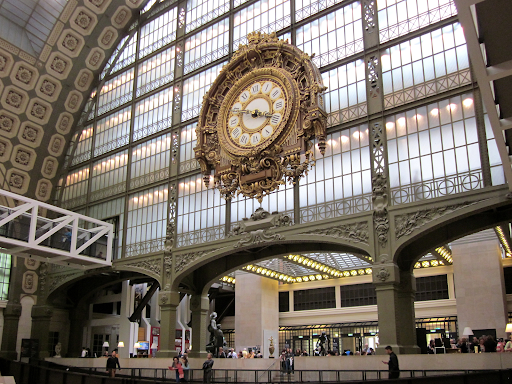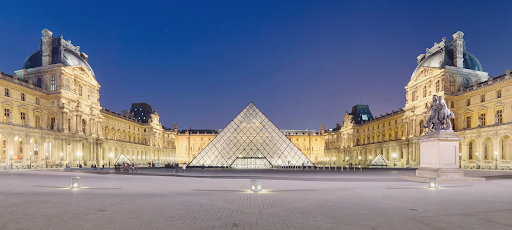Share our passion for travel! With the current situation, we are finding new ways to learn about the world around us. We encourage you to take this time to explore historical art and sites by using virtual tours.
Below is a list of some of our favorite tours you can take via computer screen: starting with our beloved Italy and also exploring other wonderful European options. Learn more about treasures you will soon be able to visit. Stay safe and enjoy your virtual vacation!
Italy
Florence
Uffizi Gallery, with the Italian flag proudly hanging.
Uffizi Gallery: Here you can explore the Uffizi Gallery, one of the most visited galleries in the world which is famous for its collection of ancient sculptures and paintings, dating all the way back to the middle ages. Located adjacent to the Piazza Della Signoria, it is in the historic center of Florence, Italy. The Gallery entirely occupies the first and second floors of the large building constructed between 1560 and 1580 and designed by Giorgio Vasari. The building itself is a work of art, but in the meantime check out what the building houses- some magnificent pieces of art!
Milan
Inside an exhibit in Brera
Pinacoteca Di Brera: The Brera Gallery was officially established in 1809. Today you are able to walk through the museum online, here. Brera became a museum to host the most important works of art from all of the areas conquered by the French armies. So unlike other important museums in Italy such as the Uffizi, Brera did not start out life as the private collection of a prince or nobleman but as the product of a deliberate policy decision. Paintings confiscated from churches and convents throughout Lombardy with the religious orders’ dissolution began to pour into the museum in the early years of the 19th century, soon to be joined by artworks of similar provenance from other areas of the Kingdom of Italy. This explains why the collection comprises chiefly religious works, many of them large altarpieces, and accounts for Brera’s special aura on which later acquisitions have had only a minor impact.
Naples
Musei Di Capodimonte: The Capodimonte Museum boasts 47,000 works of art that form one of the largest and most complex collections of medieval, early modern, modern and contemporary art in the world. In 126 galleries spread across 151,000 square feet, works of the great artists are exhibited such as: Michelangelo, Caravaggio, Raphael, Titian, Botticelli, Simone Martini, Giovanni Bellini, Colantonio, Artemisia Gentileschi, Jusepe de Ribera, Battistello, Luca Giordano, Mattia Preti, Francesco Solimena, the Carracci, Guido Reni, Lanfranco, Bruegel the Elder, and Van Dyck to name a few. Check out the collections here.
Rome
Sistine Chapel: Walking through (or scrolling through) the Sistine Chapel is absolutely breathtaking. Here you can explore the magnificent home of the Pope located in Vatican City. Today, it is the site of the papal conclave, the process by which a new pope is selected. The fame of the Sistine Chapel lies mainly in the frescos, a technique of mural painting, that decorate the interior, most particularly the Sistine Chapel ceiling and famous “The Last Judgment” mural by Michelangelo.
The Capitoline Museums: The Capitoline Museums are composed of three main buildings surrounding the Piazza del Campidoglio and interlinked by an underground gallery beneath the piazza. Visit all 3 buildings here to see its historic collections. The history of the museum can be traced to 1471, when Pope Sixtus IV donated a collection of important ancient bronzes to the people of Rome and located them on the Capitoline Hill. Since then, the museums' collection has grown to include many ancient Roman statues, inscriptions, and other artifacts; a collection of medieval and Renaissance art; and collections of jewels, coins, and other items.
Torino
Castello di Rivoli Museo d'Arte Contemporanea: Castello di Rivoli (Castle of Rivoli) is home to Museo d'Arte Contemporanea, the museum of contemporary art, the first museum devoted to contemporary art in Italy. Despite its collection of contemporary art, the castle itself is estimated to be built in the 9th or 10th centuries. A blend of modern art and historic building makes this a unique museum to visit. Make sure to check out the Collezione Cerruti, a recent acquisition or a private collector.
Venice
Musei Civici di Venezia: This museum manages and develops the cultural and artistic heritage of Venice and the island.. There are a total of 11 museums run by the Fondazione Musei Civici di Venezia. The Doge’s Palace is one of the 11, which you can watch a video of here. The Doge's Palace is built in Venetian Gothic style and one of the main landmarks of the city of Venice in northern Italy.
Scuola Grande di San Rocco: A building in Venice, northern Italy. It is noted for its collection of paintings by Tintoretto and generally agreed to include some of his finest work. See some of his work among others here.
The Scuola Grande di San Rocco is a lay confraternity founded in 1478. It is a unique site, where over 60 paintings are preserved in their original setting in a building that has hardly undergone any alteration since its construction. The confraternity is still active today, carrying out its traditional charitable duties as well as looking after its extraordinary artistic patrimony.
Amsterdam
Rijksmuseum: Explore the masterworks from the Dutch Golden Age, including works from Vermeer and Rembrandt at the Rijksmuseum. With the street view tour of this museum, you can feel as if you are actually exploring the halls of this magnificent building.
The Van Gogh Museum: This museum, is home to the largest collection of paintings, drawings, and personal letters of famous painter Vincent Van Gogh (1853-1890). Learn all about the life of this artist while getting (almost) up close and personal with his stunning artworks.
England
The British Museum: The British Museum, located in London, offers a unique experience to explore their collection of artifacts from around the world, the site includes audio, allowing the user to have a private tour guide to walk them through the collections.
The National Gallery: Housed in Trafalgar Square, the National Gallery houses a collection of over 2,300 paintings dating from the mid-13th century to 1900. Click here to explore the halls of this museum which is among the most visited art museums in the world, after the Louvre, the British Museum, and the Metropolitan Museum of Art.
France
The Musée d'Orsay: You can virtually walk through The Musée d'Orsay, a popular gallery that houses dozens of famous works from French artists who worked and lived between 1848 and 1914. The collections are housed in the former Gare d'Orsay, a railway station built between 1898 and 1900. Take a peek at artworks from Monet, Cézanne, and Gauguin, among many others.
The Louvre: The Louvre is the world's largest museum and a historic monument, that is a central landmark of the city. In 2019, the Louvre received 9.6 million visitors. The museum is housed in the Louvre Palace, originally built as the Louvre Castle in the late 12th to 13th century under Philip II. Remnants of the fortress are visible in the basement of the museum. The building was extended many times to form the present Louvre Palace, where here you can explore the collections now housed in the Palace. In 1682, Louis XIV chose the Palace of Versailles for his household, leaving the Louvre primarily as a place to display the royal collection, including, from 1692, a collection of ancient Greek and Roman sculpture.
Athens
Archaeological Museum: The National Archaeological Museum is the largest museum in Greece and one of the most important in the world. Originally destined to receive all the 19th century excavations, mainly from Attica and other parts of the country, it gradually took the form of a central National Archaeological Museum and was enriched with finds from all parts of the Greek world. His rich collections, enumerating more than 11,000 exhibits, offer the visitor a panorama of ancient Greek culture from the beginning of prehistory to the late antiquity.
Russia
Saint Petersburg
Hermitage: St. Petersburg's most popular visitor attraction, the Hermitage, one of the world's largest and most prestigious museums, is a must-see for all first-time travelers to the city (or via virtual tour, here). With over 3 million items in its collection, it also definitely rewards repeat visits, and new-comers can only hope to get a brief taste of the riches offered here.
One estimate has it that you would need eleven years to view each exhibit on display for just one minute. The virtual tour allows you to visit each collection that interests you, during times that work best for you.
Spain
Madrid
Prado: The Museo del Prado is an institution dating back almost 200 years and it’s origins and unique nature are largely due to the collecting tastes of Spain’s 16th and 17th century monarchs. Collecting at that period differed from the present day. Rather than aiming at comprehensiveness, collectors aimed to assemble as many works as possible by their favorite artists. The Prado has been described as a museum of painters not of paintings, with the largest holdings of Bosch, Titian, El Greco, Rubens, Velázquez and Goya, some numbering more than 100 works. View the artworks here.
Since its foundation in 1819, the Museo del Prado has played a key role in the evolution of art history. It has been crucial for the rediscovery of the Spanish Primitives and emblematic figures.


















